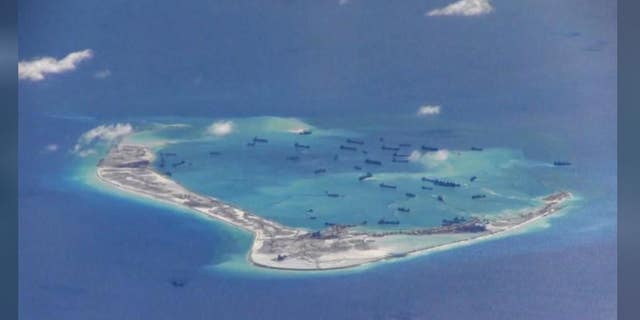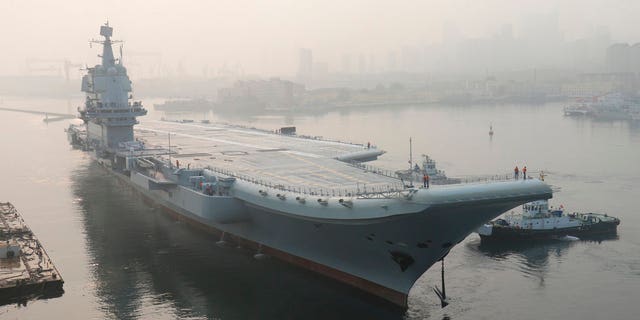By DAVID MULRONEY
 Title Everything Under the Heavens: How the Past Helps Shapes China’s Push for Global Power
Title Everything Under the Heavens: How the Past Helps Shapes China’s Push for Global Power
Author Howard W. French
Genre Non-Fiction
Publisher Knopf
Pages 330
Price $36.95Donald Trump isn’t the only global leader with wall-building ambitions.
Xi Jinping recently called on his officials to encircle restive Xinjiang province, home to China’s Muslim Uyghur population, with a “Great Wall of steel.”
Trump’s Great Wall can be dismissed as an opportunistic policy gambit, but Xi’s wall-building impulse has deeper roots.
The default symbol for the United States is the Statue of Liberty, which famously welcomes the huddled masses.
China’s most notable structure, the Great Wall, was built to keep the masses out, particularly those with dynastic ambitions.
For China’s mandarins, trouble typically arrives in the form of the twin calamities captured in the gloomy couplet, “Nei luan, wai huan”: chaos at home and invasion from abroad.
Avoiding these linked perils remains a priority for Xi, a preoccupation that shapes his foreign and domestic policy.
Xi presides over the world’s last surviving empire, a country that has devoured ethnic rivals such as the Uyghurs and Tibetans whole, and that treats neighbouring states as vassals to be kept in line.
All non-Han “Others” are expected to understand and appreciate the concept of tian xia, or “everything under heaven,” the rather ambitious zone of influence that China has traditionally attributed to itself.
Living up to this imposing mandate means that China is forever managing others, walling them in or fending them off, hoping to pacify them with the offer of membership in a China-dominated order.
In his new book, appropriately titled Everything Under the Heavens: How the Past Shapes China’s Push for Global Power, former New York Times journalist Howard W. French makes it clear China’s sense of national superiority is of more than historical significance.
While China’s power has waxed and waned, its sense of being the Middle Kingdom has remained constant.
So, too, has its inclination to manage those who lie outside the centre.
Living up to its awesome self-image has required China to dispatch fleets and armies, and to develop a highly sophisticated diplomatic stagecraft of flattery and intimidation.
For centuries, exercising this mandate of heaven has meant relentless efforts to manage and cajole, to pacify and control.
Nothing is quite what it seems.
The generous offer of inclusion in a Chinese world masks a condescending disregard for partially sinicized neighbours, such as the Vietnamese and Tibetans, and contempt for the barbarians beyond.
The offer of a peaceful place in a Chinese world is inevitably backed up by the sword.
French’s account, not surprisingly, runs counter to the official Chinese narrative.
Admiral Zheng He, a Muslim eunuch who led a Chinese armada to Southeast Asia, Sri Lanka and the east coast of Africa, is lauded in China as an unconventional explorer.
Unlike his Western counterparts, whose voyages were marked by greed, violence and conquest, Zheng, the story goes, was an ambassador of Chinese benevolence.
The reality, as French reminds us, is that Zheng’s massive ships were actually troop carriers, whose menacing arrival conveyed a distinctly different message about the nature of the Chinese deal on offer.
Modern China continues to proclaim this theme of "benevolent" internationalism, something French challenges with numerous examples.
The most chilling is his account of the Chinese navy’s 1988 massacre of flag-waving Vietnamese troops on the disputed Johnson Reef in the South China Sea.
The Vietnamese protest is captured on a grainy YouTube video that is suddenly interrupted by Chinese naval gunfire.
When the smoke clears, the Vietnamese are, shockingly, gone.
It’s worth noting this happened just a year before the Chinese military perpetrated another massacre, this time of student protesters in Tiananmen Square.
Nei luan, wai huan.
China is clearly in the midst of a new period of exuberance and expansion, and, as French makes clear, this inevitably involves friction with the two powers, Japan and the United States, that have come to dominate its neighbourhood over the past 200 years.
In recent decades, Japan, seduced by the lure of the China market and by the friendly pragmatism of previous (and needier) Chinese leaders, played down territorial disputes as it helped to rebuild China. The tables have since turned.
All things Japanese are now demonized by China, which evokes past Japanese aggression as it steadily encroaches on the rocky outcroppings that mark the beginning of the Japanese archipelago.
Even more worrisome is China’s growing rivalry with its most formidable adversary, the United States.
China is rapidly acquiring the weapons and technology to make it highly risky for the U.S. Navy to operate in the western Pacific, an ambition furthered by China’s construction of military airstrips on artificial islands in the South China Sea.
French ominously quotes another Chinese aphorism: “When two emperors appear simultaneously, one must be destroyed.”
French suggests the current period of Chinese expansionism is particularly dangerous not just because it involves a clash between two nuclear-armed powers, but also because China’s leaders are in a race against time.
The window on their ambitions for regional and broader domination is closing.
China’s slowing economy means less money for military modernization.
Worse for China is the fact its population will likely peak by 2025, while the United States will continue to enjoy a steadily increasing population, and resulting economic growth, for a long time to come.
Much of this U.S. population growth will be powered by immigration.
Trump may wish to rethink his wall.
All of this matters for Canadians.
Any armed clash between the United States, our closest ally, and China would be devastating.
Even if conflict is avoided, we can expect China’s larger ambitions and anxieties will influence the way it manages relations with Canada.
The carrots and sticks are familiar.
Trade is one potential motivator.
Even though it flows in China’s favour, its partners, Canada included, are all-too-easily persuaded that permission to do business is a benefit conferred only on those who agree to play by China’s rules. And access to China’s leaders is so carefully meted out and stage-managed that it becomes an objective in itself.
Leaders refuse to kowtow at their peril.
Recall that former prime minister Stephen Harper was widely castigated for declining to attend the Beijing Olympics in 2008, which took place only months after ugly scenes of unrest and repression in Tibet.
For Canada, managing relations with an expansionist and impatient China will not be easy.
French’s closing words seem particularly apt for us.
He notes, reasonably enough, that China has much to contribute and deserves to be treated as an equal.
That’s not a problem.
It’s the next part of French’s formula that Ottawa so often either avoids or gets wrong.
It is also important, he says, to approach China with “understated but resolute firmness.”
That’s another way of saying that, like China, we need to align our international strategy with a hard-nosed reading of national interest.
Let’s hope Ottawa’s mandarins are paying attention.

_demonstrates_small_craft_incursion_deterrence_by_using_their_forward_mounted_.50_caliber_machine_guns.jpg)



































